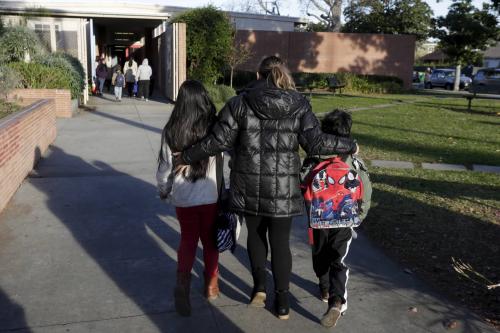If you want more content like this, subscribe to our newsletter.
This week in Class Notes:
-
- Depression weakens the relationships between low-income fathers and their children, but parental self-efficacy mitigates this effect.
- Successive expansions of the EITC since 1975 have increased employment among less-educated unmarried mothers by 3.9 percentage points.
- Schools play a role in students’ socioemotional development, which affects educational outcomes.
- This week’s top chart shows that since the Great Recession, the top income quintile has seen significant growth in real personal income.
- Anne Helen Petersen punctures any illusion of a comfortable middle-class life, and shines a light on its economic realities in this week’s choice op-ed.
- Check out our latest brief outlining a post-COVID plan for the middle class.
- For your calendar: Watch upcoming Brookings webinars on worker mobility, technology access and race, or 21st century education reform.
Depression weakens fathers’ relationships with their kids
Since 1995, the Head Start and Early Head Start preschool programs have provided comprehensive childhood services to low-income families, with a particular emphasis on engaging fathers. According to Gerard Chung and his coauthors who study over a hundred low-income fathers in the program, paternal mental health is taking a toll on relationships with children. Fathers exhibiting symptoms of depression report less close, more conflictual relationships with their children. But self-efficacy blunts the impact of depression. Depressed fathers who see themselves as competent parents were closer to their children; the effect was strongest for those with severe depression.
The EITC successfully increases employment among less-educated unmarried women
The Earned Income Tax Credit (EITC) is an anti-poverty program designed to support families with children by encouraging work. But has it succeeded in increasing the share of low-income earners who work? Yes, according to Diane Whitmore Schanzenbach and Michael Strain. They conduct a long-range analysis of the five major EITC expansions, using the Current Population Survey from 1971 to 2015. All but one (the 2009 expansion after the Great Recession) increased the share of less-educated women—the primary targeted recipient group—who reported working in the previous year. Assessing the overall impact of EITC expansion, the authors estimate that a $1000 increase in the size of the maximum allowable credit is associated with a three percentage-point increase in employment levels among less-educated unmarried women.
Socioemotional development in schools leads to higher educational attainment
It is widely accepted that both “hard” skills (math, reading comprehension, etc.) and “soft” skills (communication, socioemotional skills, etc.) play an important role in educational and adult outcomes. While there’s clear evidence that schools improve hard skills, their contribution to socioemotional development (SED) is less certain. Using data from Chicago Public Schools, Kirabo Jackson and his coauthors design a value-added model to determine the effect of schools on students’ SED. They find that schools do, in fact, impact students’ self-reported SED. They also find that both SED and test scores impact student outcomes; after accounting for test scores, schools that successfully improve SED have higher rates of high school completion and college going, and fewer school-based arrests.
Top chart: Top income quintile saw the largest increase in personal income
This week’s top chart shows that while real personal income has increased for all income quintiles since the Great Recession, the top quintile has seen the most significant growth. In 2018, the top quintile accounted for over half of all real personal income.

Choice opinion: America’s hollow middle class
“Forty years ago, the term ‘middle class’ referred to Americans who had successfully obtained a version of the American dream: a steady income from one or two earners, a home, and security for the future. It meant the ability to save and acquire assets. Now, it mostly means the ability to put your bills on autopay and service debt. The stability that once characterized the middle class, that made it such a coveted and aspirational echelon of American existence, has been hollowed out,” writes Anne Helen Petersen for Vox.
Self-promotion: A recovery plan for the middle class
A prosperous middle class provides the foundation for a strong society and a healthy democracy. But the middle class is at risk; over the last few decades, middle class incomes, after taxes and benefits, have grown half as fast as those of both the rich and poor. The acute economic crisis caused by COVID-19 highlighted and exacerbated the chronic economic problems facing millions of Americans. To provide immediate assistance to the middle class, Isabel Sawhill and Richard Reeves argue that we should eliminate income tax for most middle-class households by raising the standard deduction to $100,000 for a married couple and provide two years of post-secondary education for free—in exchange for a year of national service. Both policies can be funded by higher taxes on carbon, capital, and consumption.
For your calendar: Worker mobility, technology and race, and 21st century education reform
Wednesday, January 6, 2021 10:00 AM – 11:00 AM EST
Wednesday, January 6, 2021 2:00 PM – 3:00 PM EST
Wednesday, January 13, 2021 12:00 PM – 1:00 PM EST









Commentary
Class Notes: Depression and fatherhood, personal income growth, and more
December 23, 2020